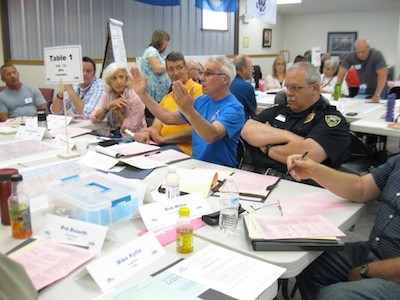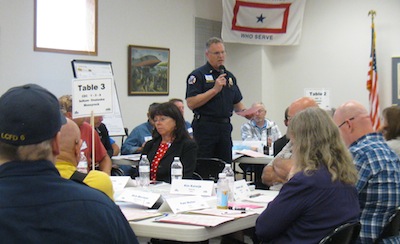
Community members discuss some of the nuts and bolts of how they might work together in the aftermath of a catastrophic earthquake.
By Sharyn L. Decker
Lewis County Sirens news reporter
CHEHALIS – Think about a 6.1 magnitude earthquake shaking for 32 seconds.
“This 9.0 is expected to shake for five and half minutes,” Jill Kangas said.
Kangas and Steve Mansfield, of the Lewis County Department of Emergency Management yesterday brought more than 100 people together to contemplate how to respond to a catastrophic event that would affect the entire Pacific Northwest.
“This scenario is going to be so far beyond anything we have experienced or prepared for,” Mansfield said. “We don’t have a plan in place (for this).”
Mansfield pointed to a large map.
“What I want you to see here is, there’s not going to be a lot of movement on I-5,” he said. “People are not driving, but walking, if they’re still alive.”
The six-hour gathering in the upstairs meeting room of the Lewis County Veteran’s Museum in Chehalis was the local portion of Washington state’s Cascadia Rising earthquake and tsunami simulation exercise. It’s meant to test local, state, tribal and federal government as well as select private sector and non-governmental organizations’ ability to deal with such a situation.
The Cascadia subduction zone, lying mostly offshore, is an approximately 800-mile long fault, running from British Columbia to California. Stresses have been building there for more than 300 years and experts say we can be certain another great quake will shake the region.
Based on a show of hands, only one person in the room had experienced an earthquake of 7.0 magnitude or greater.
Chehalis Fire Department Chief Ken Cardinale told the group what his agency saw in October 1989 around California’s Bay Area. It measured between 6.9 and 7.2, he said.
There was $5 to $6 billion in damage, 63 people were killed and more than 3,000 injured, Cardinale said. The Bay Bridge went down. The aftershocks were 4.0 to 5.0 in magnitude, he said.
“We had 1,700 calls to 911 in the first hour,” he said. “Dispatch became just a call taking center; our department had to dispatch itself.”
Mutual aid from neighboring departments was nonexistant, he said, because they too were affected.
Cardinale offered the lesson for the day: “Everything you know about day to day operations will not be able to put into place in an event like this.”
Yesterday’s participants were seated at eight tables, each representing an area in the county imagined to be entirely cut off from other areas when a magnitude 9.0 earthquake strikes.
The scene: Buildings are in rubble, utilities are down, communications and transportation systems are critically impaired.
There is no Internet. People may or may not be able to use the text function on their cell phones.
Throughout the county, 1,200 people are dead, 2,460 individuals are seriously injured and 12,000 others are without shelter.
Each group was tasked with identifying its resources, building its team and developing action plans for the first 24-, 48- and 72-hour periods.
“What I kind of see is people going to their local fire stations,” Napavine resident and candidate for Lewis County commissioner Bob Bozarth said at the table for the Centralia area.
“They will, you’re right,” Riverside Fire Authority Chief Mike Kytta responded. “They’re going to go there and to doctors’ offices.”
“We don’t have a local search and rescue team, so we’re going to have to organize that,” Kytta said.
They pondered where to set up a command post.
The city of Centralia operates an emergency operations center at City Hall during disasters, such as flooding.
“Our building will probably be dust,” Centralia Police Department Cmdr. Pat Fitzgerald said. “The EOC will probably just pop up where the EOC pops up, that’s the reality.
It could be the hood of some random person’s car, he speculated.
At the Napavine table: “We’re going to check on our neighbors.”
At the Boistfort-Pe Ell-Curtis table: Boistfort and Pe Ell already have a supply of food and water for 100 people. “Water is paramount,” Justin Phelps, public works employee for the town of Pe Ell says.
At times, the various groups shared with the entire room.
From the Toledo-Winlock-Vader table: Mark Anders spoke about the strategy for finding people who need help.
“You’re going to go house to house, to the areas that are the easiest to get to first,” he said. “To help the most people the quickest.”
From the Salkum-Onalaska-Mossyrock table: The Mossyrock and Mayfield dams are built to withstand Morton area earthquakes and should be fine in this scenario, Tacoma Public Utilities employee Jayson Lelli said.
Nobody from TransAlta was present to speak to the strength and expectations of the Skookumchuck Dam.
Former Lewis County Commissioner Ron Averill spoke up.
“That’s an earthen dam,” he said. “If it breaks, Centralia will be under water to the Miracle Mile.”
From the Chehalis table, Chief Cardinale: “One of the options we thought about for sheltering people, is we’re fortunate to have RV sales places around here.” he said. “Even if buildings are standing, with aftershocks, people are going to be afraid to go back in.”
“We also had the idea of commandeering National Frozen Foods,” Cardinale said.
The imagined number of dead in Chehalis is 384.
Lewis County Coroner Warren McLeod, on what to do with the bodies:
“In the first hours, it’s not an issue,” McLeod told the group. “Our main concern would begin at the eighth hour.”
There’s insects, then rodents, he said. “You’ll begin to see mountain lions, bears and pack of dogs,” he said.
“Our plan is, they get buried where they are found,” McLeod said.
Specifically, McLeod said, to bury 200 people, it will take 400 square feet of space and moving 1,300 cubic yards of dirt.
Rationing limited resources will become a reality. No help can be expected from the outside for days, attendees were told.
“Stores don’t carry more than one to two days worth of supplies for their community,” Mansfield said. “Ten years ago, that was different.”
When help from the outside is mobilized, it will head first to the affected areas with the densest populations, such as Seattle and Tacoma, he said.
“If you think the military is going to be here within the first 72 hours, you’re wrong,” he said.
•
Tags: By Sharyn L. Decker, news reporter

What a waste!!!!
This was not a waste of money or time. You morons that think so will be the first to go in this form of natural selection. Just remember where you live, surrounded by active volcano’s and on all different kinds of earthquake fault lines. The big one is coming, it’s just a matter of time. These training sessions are portrayed as worst case scenerio’s for good reason. If training goes well for worst cases, then any other level of tragedy will be better handled. Some of you just need a little sense slapped into you!
It’s good mgt to prepare for eventualities even if those events never arrive. We wdn’t want local and state officials to do otherwise.
You said it Bo!
During Hurricane Katrina the National Gaurd went door to door rounding up guns from people who needed them for protection. Never expect anything for free from the Government. The only thing thats free is the Fluoride they put in you’re water to soft kill you and you’re family. Have at least 30 days of self heating MRE’s ready for each person. Store water and ammunition also. When the SHTF police uniforms will be nothing more than worthless rags, police will abandon their posts and participate in the looting of pharmaceys and banks. Dig in and take care of you’re own family the Government is a proven fail.
This was meant as a training tool to get our communities focused on being proactive instead of reactive in the event of something catastrophic impacting our region. Those who choose to prep & plan for a natural disaster will be more likely to survive. On the other hand, those who choose to bury their head in the sand and think the government will take care of them, you’re wrong. These are the ones that will be weeded out of society…natural selection…survival of the fittest. What are you going to do when all the bridges go down? Not just the big bridges & overpasses, but think of all the little river & creek crossings. How long will the fuel in your vehicle last? Do you have a backup heat & power source? What happens when the store shelves are empty and the ones at home are also? Canabolism? Clean water source?
Once again a big giant waste of time and money
The main thing from all of this……be prepared to take care of yourselves in a major disaster. Relying on the government to provide for all of the needs is going to result in huge disappointment. Pea Body said it: Take care of you and yours.
During a narural disaster like Hurricane Katrina the police shot and killed people trying to cross a bridge to safety. Take care of yourself it’s your Duty.
The walking dead down I-5? Commandeering food processing buildings to freeze bodies? Mountain lions, bears, packs of dogs? Bury the bodies were they lay?! This is the best we get from our local leaders? Insanity, ignorance, or sensationalism? I’m not sure. None of this has happened in even the largest of disasters within the United States. How much are we paying Mansfield to watch Book of Eli and jot down notes on apocalyptic response and calling it emergency management?